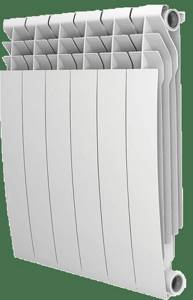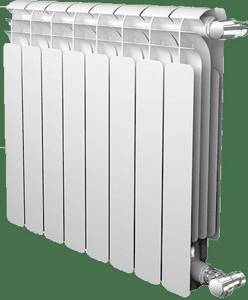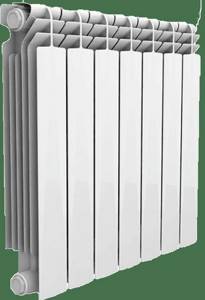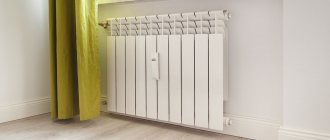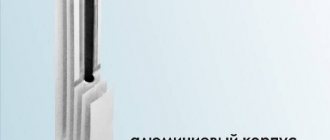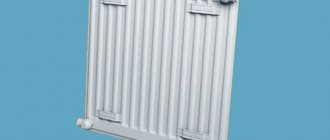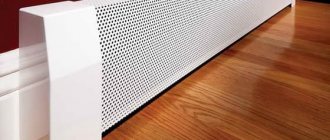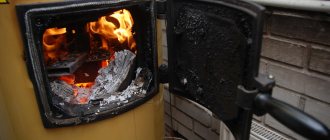Reliable warmth from aluminum and steel
Categories:
- The best bimetallic sectional radiators with side connection
- The best bimetallic sectional radiators with bottom connection
- The best bimetallic tubular radiators
Bimetallic radiators are a compromise between heavy and ugly cast iron ones and nice, but not the most reliable aluminum ones. Stainless steel has made the latter much more resistant to an aggressive environment, which most often represents the harsh and merciless domestic coolant. Our rating includes the best bimetallic radiators, reliable and with good heat dissipation.
CategoryPlaceNameRatingPrice
| The best bimetallic sectional radiators with side connection | 1 | Global STYLE PLUS 500 | 9.9 / 10 | 8 091 |
| 2 | Rifar Monolit 500 | 9.8 / 10 | 6 305 | |
| 3 | Sira RS Bimetal 500 | 9.8 / 10 | 8 518 | |
| 4 | Royal Thermo Revolution Bimetall 500 | 9.6 / 10 | 4 105 | |
| 5 | Radena CS 500 | 9.6 / 10 | 5 980 | |
| The best bimetallic sectional radiators with bottom connection | 1 | Rifar Monolit Ventil 500 | 9.7 / 10 | 9 013 |
| 2 | Rifar Base Ventil 350 | 9.6 / 10 | 7 683 | |
| The best bimetallic tubular radiators | 1 | KZTO Elegant 1 250 | 9.5 / 10 | 7 978 |
Method of connecting sections
In bimetallic heating radiators, the sections are connected to each other using steel threaded nipples. In the manufacture of Monolit series radiators from the Rifar company, another type of connection is used - welding. This model of heating devices can withstand increased pressure (operating up to 100 atm) and temperature (up to 135°C versus 110°C for nipple models).
Diagram of a monolithic radiator.
Bimetallic radiators are the most technically advanced heating device for water heating systems. Combining high efficiency and good performance indicators, devices of this type are optimal for use in domestic conditions. Knowing the technical characteristics of bimetallic heating radiators of various models, you can choose a heating device that best suits the operating conditions in a particular room.
Which radiators are better - aluminum, cast iron or bimetallic?
Of course, the most durable are cast iron radiators, which last more than 30 years and even longer due to their resistance to pressure changes and the negative effects of low-quality coolant. They look like ordinary batteries. Aluminum and bimetallic models have a flat base and consist of several sections, the number of which, depending on the product, can be changed.
| View | Advantages | Flaws |
| Cast iron | Heats nearby objects | Gives off heat more slowly |
| Suitable for any type of heating system | Heavier | |
| Can easily withstand exposure to coolant of any quality | ||
| Aluminum | Affordable price | Less selection |
| Easy to install | Holds paint worse | |
| Large pressure resource | Corrosive instability | |
| Bimetallic | Not afraid of pressure surges | Requires water drainage for summer |
| Corrosion resistant | Not the thickest walls | |
| Light weight | Lasts less than cast iron |
Cast iron batteries have almost become obsolete in the form in which they were installed during the Soviet era. They are relevant mainly in rooms decorated in a “retro” style. In modern renovations, bimetallic or aluminum types are most often chosen, although the former are cheaper and more accessible.
What is bimetal
Bimetal is a relatively new type of heating battery material that consists of two metals, a steel core inside and an aluminum casing on top. This combination is designed primarily to work with high pressure in radiators, up to 40 atmospheres.
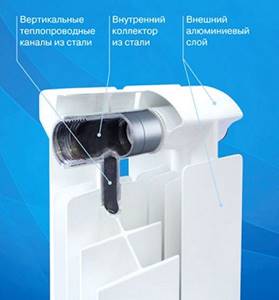
Without understanding what bimetallic heating radiators are and how they function, it is impossible to think through the heating system of a home. Even if you prefer more economical options, do not rush to abandon bimetal products - after all, they have very high performance characteristics.
When developing such batteries, the designers set out to produce a product that would have the high heat transfer properties of aluminum, but would not have the disadvantage of poor corrosion resistance. The result is a heatsink that incorporates a less demanding steel core within an aluminum shell.
This product perfectly heats the room - the section power is up to 190 W, but lasts an order of magnitude longer than its aluminum “brother”.
Bimetallic heating devices today are the best choice for a city apartment. Elegant and powerful, like aluminum, they perfectly withstand high pressure, water hammer and resist corrosion. Such devices have been successfully used for a long time in open urban heating systems in many Russian cities.
The collectors and vertical channels of such radiators are made of steel tubes, and the outside is filled with aluminum alloy under pressure. Steel holds pressure well, and aluminum transfers heat well to the air.
- It has many other advantages:
- tolerate water hammer well during seasonal startup work;
- ease and simplicity of installation;
- their laconic and elegant appearance makes them suitable for any interior;
- can withstand pressure up to 35 atmospheres;
- can last up to 20 years.
As mentioned, the main disadvantage of such products is their high price. In addition, although steel is more resistant to corrosion than aluminum, it still suffers from it. Especially if air bubbles get into the system. If the coolant is of very low quality and contains small particles, the bimetal will also not be a panacea for rapid wear.
Advantages of bimetal
The popularity of modern bimetal radiators is not accidental. They are distinguished by a set of unique properties and advantages.
- The thoughtful design of the case is created for maximum heat transfer and free air circulation based on the principle of convection.
- Radiators are assembled from sections, which makes it easy to extend or shorten them depending on the needs of the homeowners.
- Monolithic structures are characterized by the highest resistance to water hammer, complete elimination of leaks and a service life of up to 100 years.
- Bimetal batteries have an attractive design, are available in a variety of colors and are coated with a two-layer paint composition that is protected from damage and fading.

- The aluminum body heats up quickly and cools down just as quickly, which makes it possible to fine-tune the temperature using the regulator.
- The steel or copper collector of bimetallic radiators is able to constantly withstand chemically active coolant.
Note! To prevent corrosion, it is necessary to bleed the air regularly to prevent prolonged contact of oxygen with the inside of the device.
- The devices demonstrate high resistance to heat and can withstand even 130 °C.
- A well-thought-out connection system makes installation very simple.
Sectional or monolithic bimetal?
More common on the market is the sectional version of bimetallic heating radiators. This is justified by the fact that it provides greater scope for installation in various conditions. It allows you to easily add or subtract the required number of sections when calculating the heating area and has an affordable price.
The monolithic design has improved performance characteristics: it can withstand significantly higher coolant pressure, easily withstand even the most powerful water hammer and have a service life of 100 years. Leaks between blocks that are possible with sectional radiators are also eliminated. The described qualities are achieved due to a solid steel core, which has no weak points in the form of docking nipples.
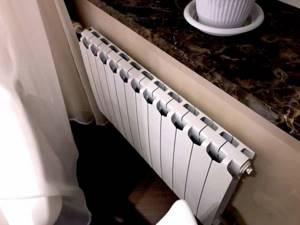
The main disadvantage of monolithic bimetal is its high cost.
Standard battery dimensions
The dimensions of bimetallic radiators are exactly the same as other types of heaters. They are determined by the center distance between the lower and upper horizontal collectors. These parameters should not be considered the size of the entire structure. To calculate the height of a bimetallic radiator, add 80 to the center-to-center indicator indicated on the product. There are three center-to-center distances - 200, 350 and 500 mm, but these are not the only parameters of these devices.
- the length of the standard section is 80 mm;
- depth – from 75 to 100 mm;
- height – 550-580 mm.
To calculate what height, for example, standard bimetallic radiators are 500 mm, you need to add 80 to this indicator, and the resulting 580 mm is its true size, which should be taken into account when determining the place where it will stand.
In addition to standard models, there are so-called designer versions of bimetallic radiators.
Center distance
The center distance is the distance between the location of the lower and upper collectors. As a rule, the parameter is indicated in millimeters. Standard sizes are available from 200 to 800 mm. These options are usually enough to match the radiators to the wiring installed in the room.
More often on the market there are products with a distance between the cores of 500 and 350 mm. These sizes are standard for most modern new buildings. Difficulties arise when finding narrow 200mm batteries that are well suited for a small kitchen or toilet, while wide 800mm products are usually only available to order.
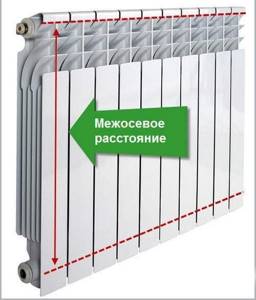
Capacity of the bimetallic radiator section
The main characteristics of bimetallic radiators include section capacity . This parameter directly depends on the center distance. For the most common 500 mm models, the section capacity is 0.3 liters of coolant .
In bimetallic heating radiators, the coolant circulates through steel cores - H-shaped welded structures, which consist of a lower and upper collector connected to each other by a heat conductor (vertical tube). Each manifold has two internally threaded side holes for connecting the sections using steel nipples. With this design, the coolant does not come into contact with aluminum parts, which increases the service life of the radiator. The steel cores of bimetallic devices use only round tubes, so the capacity of the sections of such devices is less than that of aluminum ones, in which the heat conductor has an oval cross-section.
Note that a round steel insert mounted inside a bimetallic radiator ensures long-term heat retention . Due to the relatively small volume of the section, thermal inertia is reduced, resulting in reduced costs for maintaining heat.
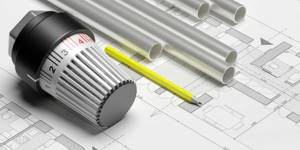
Thermal bimetals: characteristics and applications
Materials of this type are usually strips that can bend with changes in temperature. One layer of such composites consists of a metal with a high linear expansion coefficient. This could be, for example, some alloys. Also, non-ferrous metals are often used to produce such a layer in thermal composites. The second layer of this type of material is usually made from a virtually non-expandable alloy of nickel and iron.
Bimetals of this type are most often used for the manufacture of various types of devices. These could be, for example, thermostats, protective relays, thermometers.
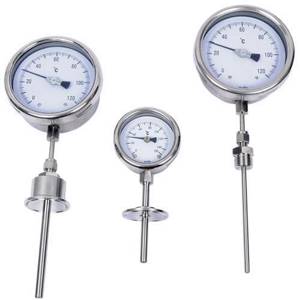
Areas of application
We have thus found out what a bimetal is. In the petrochemical industry, such composites are commonly used to make corrosion-resistant equipment. Also in this area, such composites are used to produce elements with a strengthened working surface.
In the nuclear industry, bimetallic tube sheets are very often used. The following are also made from such composites:
- capacitor banks of turbine units;
- containers for storing purified water;
- containers for chemical reagents.
In the electrochemical industry, such metals are often used in the electrolysis production of chlorine for water purification. In shipbuilding, composites of this type can be used:
- in engineering communications;
- deck superstructures;
- in the manufacture of ship hulls in contact with ice and snow.
The best bimetallic radiators with a center distance of 35 cm
Bimetallic radiators of this type are characterized by a stylish design, small weight and size indicators and good heat dissipation. But such models have weak convection due to the small height of the panel.
ROYAL Thermo Revolution Bimetall 350 – best price-quality ratio
This model is distinguished from analogues by its high quality, which the manufacturer indicates with special markings that protect each product from counterfeiting. The upper fins have a more wavy structure. By moving heat flows in two directions, the heat transfer of each section increases by 5%. The main feature of the radiator is a 7-layer coating, which allows the device to be used in rooms with high humidity levels.
Advantages:
- Reliability.
- Long service life.
- Excellent quality.
- High heat dissipation.
- Manufacturer's warranty for 15 years.
Flaws:
- Impressive value.
The Thermo Revolution model is ideal for use in central heating systems.
RIFAR Monolit 350 - reliable and affordable batteries with side connection
This model has excellent characteristics and is undemanding to the quality of the coolant. Thanks to the solid steel frame, the radiator is reliable, durable, has good heat transfer, corrosion resistance, and the ability to withstand coolant temperatures up to 135 ° C and pressure up to 15 kg/cm2. The three-layer coating allows you to maintain the magnificent appearance of the device throughout its entire operation.
Advantages:
- Reliability.
- Durability.
- Modern design.
- Good heat dissipation.
- Possibility of connecting a thermostat.
Flaws:
- Lack of installation kit.
Rifar Monolit 350 is perfect for heating small rooms with ceiling heights up to 2.7 m.
GLOBAL Style Plus 350 – model with impressive working pressure
Wall-mounted model with a monolithic frame design, which is offered by the manufacturer in 4, 6 and 10-section versions. The main feature of Global radiators is their impressive operating pressure (35 kg/cm2). But heat dissipation is not a strong point of this model - only 86 W per section. The maximum coolant temperature is 110 °C.
Advantages:
- Low cost.
- Steel frame.
- Excellent operating and pressure testing performance.
- Modern design.
Flaws:
- Relatively low heat transfer.
STYLE PLUS is an excellent purchase for heating small spaces. However, we should not forget that the connection diameter of this radiator is 1 inch. For ¾ or ½ inch wiring, you will need an adapter.
- ROYAL Thermo Revolution Bimetall 350
- RIFAR Monolit 350
- GLOBAL Style Plus 350
Advantages and disadvantages of bimetallic radiators
In the end, we invite you to familiarize yourself with the positive and negative aspects of using radiators. Let's start with the pros:

As for the disadvantages, they also exist:
- the main one is high cost. But, given the technical characteristics and quality of the products, the price is quite justified;
- the core of steel pipes can rust under the influence of coolant and air. This occurs during repairs or an accident in the system. In this case, you have to drain the water, and the air begins to affect the pipes. They can also rust from antifreeze, which is used in private homes. In this case, it is better to choose solid batteries or pure aluminum ones;
- the last drawback is the small flow area of the pipe.
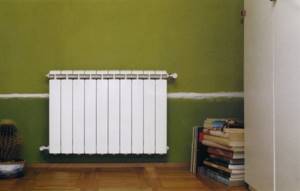
These are bimetallic heating radiators. It’s safe to say that so far on the market they simply have no equal in characteristics, performance, appearance and parameters. Many users who purchased the products are quite satisfied with their purchase.
The best bimetallic radiators with non-standard distance between axes
Such models can have an extremely intricate design, which affects the center distance, heat transfer parameters and supply options.
TIANRUN Rondo 150 – durable and reliable heating device
This compact floor-standing model can withstand pressures of up to 25 bar at coolant temperatures of up to 135°C. This strength is achieved through the use of a solid steel frame. The absence of leaks between sections is guaranteed by high-strength forged steel nipples and special silicone gaskets.
Despite its extremely compact dimensions with an interaxial distance of only 150 mm, the radiator has good thermal power (95 W at a coolant temperature of 70°C).
Advantages:
- High strength and reliability
- Good technical and operational characteristics.
- Thoughtful geometry of the body ribs.
- Light weight.
Flaws:
- The floor bracket is not included.
Tianrun Rondo is a good solution for heating rooms with a large glass area.
SIRA Gladiator 200 – compact battery
The wall-mounted bimetallic radiator with a classic side supply received a design focused on safety during operation. The main feature of this model is its small dimensions - as a result of the center distance reduced to 20 cm.
Despite its compactness, the bimetallic radiator has very good operating pressure (35 bar) and can withstand temperatures up to 110 °C. However, the dimensions affected the modest heat transfer - only 92 W per section.
Advantages:
- Reliability.
- Compactness.
- Light weight.
- High operating pressure.
- Elegant design.
Flaws:
- Medium heat dissipation.
SIRA Gladiator is a perfectly suitable model for heating small rooms.
We choose the best bimetallic radiator with a non-standard distance between the axes!
- TIANRUN Rondo 150
- SIRA Gladiator 200
Which bimetallic heating radiator is better to choose for an apartment?
When installing new and replacing old heating devices in apartments with bimetallic products, it is necessary to take into account the boundary parameters of the operating pressure for which it is designed.
You also need to take into account the quality of the coolant and if it is low, then you need to choose models in which the steel frame made of tubes is treated with an anti-corrosion internal coating.
The best radiators for apartments will be batteries that can withstand pressure surges of up to 30 atm. It is important to take into account the standard pressure in the centralized heating network.
Radiators: aluminum or bimetal? “Never bet!” And other myths.
The best models in terms of price/quality ratio
Let's consider the rating of bimetallic radiator models that are of high quality at an affordable price.
Royal Thermo BiLiner 500 x6
This model is equipped with protection against water hammer and chemically aggressive coolants.
Radiators are available in white, gray, black, which allows you to choose the best option to suit the design of the room.
Ultra-resistant 7-level painting prevents chips and cracks on the surface. One of the main advantages of the model is that it comes with a 25-year warranty.
The design consists of 6 elements.
Specifications:
- design - wall-mounted;
- type - sectional;
- connection - lateral;
- maximum operating pressure - 30 bar;
- height - 57.4 cm;
- width - 48 cm;
- thickness - 8.7 cm;
- weight - 11 kg.
Advantages
- long warranty period;
- stylish design;
- the ability to choose a specific color;
- a light weight;
- good heat dissipation;
- high-quality coating;
- ease of installation.
Flaws
- the radiator is qualitatively painted only on the front side;
- sometimes you come across models with defective threads;
- not always high-quality assembly.
Recommendations for selection
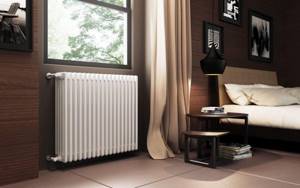
In order to decide where to buy radiators, you need to look through the catalogs of several online stores. This way you can get an idea of each type of product on the market today. This will also help to determine the average price for the sample you like. However, you should not give preference to little-known manufacturers and expensive new products. Perhaps the sample you need is produced by a domestic concern.
There are only four materials from which water convectors are made:
- Bimetal (monolithic units consisting of a certain number of sections).
- Cast iron.
- Aluminum.
- Steel.
When choosing a unit, you should select its power correctly. To do this, you will need to independently calculate the required amount of heat and the existing supply standards. There are several ways to implement your plan. It is possible to use data regarding the volume of the room and the heat losses of the building.
Step-by-step instructions on how to choose a water convector

- Popular models may be suitable for all characteristics, but their cost will be appropriate. It is necessary to settle on the “golden mean”. You should not buy equipment that is too cheap, and the most expensive may not be necessary.
- An attractive appearance alone may not be enough. The selected model must be suitable in terms of functionality, color, size (height) and connection method. The battery should look organic not only in the room itself, but also fit into the niche intended for it.
- Before you buy and then install a battery in a high-rise building, you need to make sure that the heating section meets the stated characteristics. In this case, the operating pressure of the unit should be less than 12 atmospheres. Such information is contained in the product description and its passport.
It should be noted that in most cases, radiators are installed independently at home. In this case, you need to make sure that DIY installation is possible. The kit should also contain the necessary jumpers and auxiliary components that the master will need.
- But for private houses this aspect is not considered so important. Such characteristics are not taken into account during the construction and subsequent installation of the heating system. The exception is coal or wood boilers, which are responsible for heating. In this case, it is necessary to buy a sample that can function in the presence of a high-temperature coolant. The higher the indicator, the longer the batteries will last.
- The popularity of the models is important, but not as important as the method of connecting the radiator itself. The bottom liner is much more convenient for subsequent repairs and connections. This will make existing pipes easier to hide. The lateral type of connection implies that the pipes will be walled up in the walls (later it is not possible to fix the damage without subsequent repairs) or will remain visible.
- There may be several options for installing the device. Not only wall-mounted models are in demand, but also equally high-quality floor-mounted ones. The equipment will play an important role and you should pay special attention to this. It is somewhat easier to have a jumper from the same manufacturer on hand, compared to one that was bought at random in the nearest store. The last option may not fit at all in terms of dimensions. The basic kit should include footings and brackets. Otherwise you will have to buy everything yourself.
It is worth noting that valves and Mayevsky taps are often purchased separately. You should not look for such attributes in the kit. After choosing a model, you can begin selecting equipment of the appropriate power.
Table: comparison of characteristics
ModelWorking pressure, atm / Heat transfer at ΔТ=70ºС, WMaximum coolant temperature, °С Section size (HxWxD), mm / Weight, kgConnection thread diameter, inches
Rifar Monolit 350 | 40 / 138 | 135 | 415x80x100 / 1.45 | 1/2 or 3/4 |
| Rifar Alp 500 | 20 / 161 | 135 | 570x80x75 / 1.46 | 1 |
| Global STYLE EXTRA 500 | 35 / 171 | 135 | 565x81x80 / 1.97 | 1 |
Royal Thermo Vittoria 500 | 30 / 175 | 110 | 560x80x80 / 1.9 | 1/2 |
| Royal Thermo Revolution Bimetall 350 | 30 / 130 | 110 | 415x80x80 / 1.42 | 1/2 |
Sira Ali Metal 500 | 35 / 187 | 110 | 565x95x80 / 1.70 | 1 |
| Halsen BM 500 BS | 25 / 204 | 110 | 568x80x96 / 1.75 | 1 |
| Sira Gladiator 200 | 35 / 92 | 110 | 273x80x80 / 0.78 | 1 |
| ROMMER Profi Bm 500 | 20 / 143 | 110 | 565x80x80 / 1.5 | 1 |
| ROMMER Optima Bm 500 | 30 / 129 | 110 | 557x77x78 / 1.22 | 1 |
| Radena CS 500 | 25 / 152 | 110 | 350x80x85 / 1.78 | 1 |
Fondital Alustal 500/100 | 40 / 191 | 110 | 559х80х97 / 1.89 | 1 |
Any model from this list should only be purchased from official representatives. It is difficult to determine the origin of batteries, whether it was made at the manufacturing plant or is a Chinese counterfeit. In the second option, the buyer, at best, is left without a guarantee; at worst, he will receive a bill for a substantial amount for repairing the ceiling of his flooded neighbors.
Characteristics of bimetallic radiators from some manufacturers
1. Reliable and high-quality, but expensive batteries are made by the Italian company Global Style. Moreover, the technical characteristics of bimetallic radiators made by this company can be called ideal. Russian buyers have long appreciated these batteries, knowing that they were approved by experts from the Plumbing Research Institute and developed for Russian operating conditions. Already the second line of three models has seen the light. A ten or twenty year warranty is provided by the manufacturer.
Global Style Extra and Global Style Plus batteries are famous for their high heat transfer coefficient (no worse than semi-bimetal models). They are beautiful and durable, but a little expensive. Simpler and cheaper models transfer heat a little worse and are less elegant, but they also look good. They are neat and small, and have very decent characteristics. The even number of sections, painted warm white, ranges from 6 to 14.
2. The Italian company Sira has been making batteries for more than half a century. Its strong point is semi-bimetallic products with high heat transfer. The company produces radiators in three varieties. Quite boringly shaped rectangular products, batteries with beautifully outlined smoothly rounded corners, as well as a model called “Gladiator”.
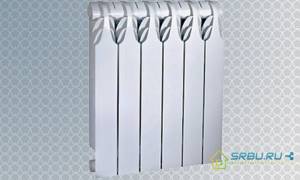
The shape of the latter is very unusual and creative.
Even sections of batteries (there can be from 4 to 10) are painted in warm shades of white. Warranty – 20 years. The factories of this company are located not only in Italy. Some of them are located in China :).
3. The Russian company Rifar (Orenburg region) has been making batteries relatively recently - since 2002. But it has already won sympathy in the domestic market, and has also successfully entered the CIS level. Its products include seven types of semi-bimetal radiators. The “Monolith” (a new development with a patent) and “Rifar Flex” (can be bent to fit bay windows) models are especially popular.
The bright white sections of these radiators are supplied in packs of 4 to 14 pieces. Rifar guarantees trouble-free service of products for 10-25 years. There are usually three leading models available. The rest of the range is available upon request.
Table. Comparative characteristics of various manufacturers and models of bimetallic radiators
| Brand, country of origin | Model | Distance between axes, mm | Dimensions, H/W/D (sections) | Maksim. working pressure, bar. | Thermal power, W | Water volume in section, l | Weight, kg | Max. temp. tepono-sitela |
| Italy | STYLE 350 STYLE 500 STYLE PLUS 350 STYLE PLUS 500 | 350 500 350 500 | 425/80/80 575/80/80 425/80/95 575/80/95 | 35 | 125 168 140 185 | 0,16 0,2 0,17 0,19 | 1,56 1,97 1,5 1,94 | 110 |
| Italy | BiLiner Inox 500 BiLiner 500 | 500 | 574/80/87 | 20 | 171 | 0,2 | 2,01 | 90 |
| Germany | TENRAD 350 TENRAD 500 | 350 500 | 400/80/77 550/80/77 | 24 | 120 161 | 0,15 0,22 | 1,22 1,44 | 120 |
| Russia | RIFAR Forza 350 RIFAR Forza 500 RIFAR MONOLIT 350 RIFAR MONOLIT 500 | 350 500 350 500 | 415/90/80 570/100/80 415/100/80 577/100/80 | 20 20 100 100 | 136 202 136 194 | 0,18 0,20 0,18 0,20 | 1,36 1,84 1,5 2,0 | 135 |
| China | Gordi 350 Gordi 500 | 350 500 | 412/80/80 572/80/80 | 30 | 160 181 | 0,21 0,3 | 1,4 1,7 | 110 |
| Italy | Gladiator 200 Gladiator 350 Gladiator 500 | 200 350 500 | 275/80/80 423/80/80 | 30 | 90 140 185 | 0,1 0,13 0,42 | 0,65 0,85 1,6 | 110 |
Standard power value for sections with center distances of 500 and 350 mm
The heat transfer value of bimetallic radiators is indicated in the technical data sheet for the product. Before purchasing, it is advisable to read the documentation for the device, since this parameter is individual for each model. If there is no data in the data sheet, you can use the average power value of 1 section of a bimetallic radiator:
- Devices with a center distance of 500 mm are standard and the most popular. Traditionally installed in apartments. The average heat transfer value of one section of a bimetallic radiator ranges from 170 to 210 W. It is important to consider that the stated indicators are usually slightly higher than the real ones, since measurements are carried out under ideal conditions. Therefore, it is more correct to focus on the minimum power of one section of a bimetallic radiator of 150 W. The working pressure of one section is 20 bar, the pressure test is 30 bar, the average weight is about 1.92 kg.
- Devices with a center distance of 350 mm usually mounted next to large windows or in hard-to-reach places . According to the technical data sheet, the standard power value of 1 section of a bimetallic radiator is from 120 to 150 W. The real value is slightly lower - 100-120 W. The working pressure of each section is 20 bar, the pressure test is 30 bar, the average weight is about 1.36 kg.
Expert advice: when determining the optimal power of a bimetallic radiator, it is advisable to leave a small “reserve”, otherwise it may be necessary to expand the device - install additional sections.
Details about the characteristics of bimetallic radiators
When choosing radiators, you need to carefully study the passport of your favorite model. And now – about what important parameters are indicated there.
Heat dissipation
The amount of heat given off by a radiator at a water temperature of plus 70 degrees Celsius is measured in watts. The average heat transfer value for bimetal batteries is from 170 to 190 watts. It's just gorgeous.

Heat transfer occurs both by heating the air and, thanks to the special design of the radiators, by convection.
Withstand pressure during operation
It ranges from 16 to 35 atmospheres and depends on the model and manufacturer. If the heating system is centralized, then the standard pressure is no more than 14 atmospheres, and in an autonomous system it is about no more than 10 atmospheres. To prevent the battery from bursting when the pressure increases, the manufacturer usually specifies this parameter with a margin.
Center distance
This is the distance (in millimeters) at which the upper radiator manifold is separated from the lower one. The standard values are: 800, 500, 350, 300 and 200 millimeters. This variety allows you to choose a battery that will fit well into the existing heating pipe layout.
Most often, radiators with 50, 35 and 20 centimeters between the axes of the collectors are in demand.
Limit coolant temperature
Basically, bimetal radiators can withstand hot water up to 90 degrees. Sometimes the manufacturer is slightly disingenuous, promising that even boiling water at 95 degrees will not matter to the batteries. You shouldn’t believe this - none of the manufacturers produces temperatures above 90 0C. It is worth taking a closer look at this indicator - the heat transfer coefficient also depends on it.
Reliability and lifespan
Considering the characteristics of bimetallic heating radiators, you can safely use them for twenty years. No maintenance is required. That's a pretty good time frame.
Ease of installation
The sections of these radiators are absolutely identical. This allows you to install them either to the left of a suitable heating pipe or to the right. Where the pipe fits, a pipe is connected to the radiator. A plug is mounted at the opposite end, which is completed by a Mayevsky tap (on the side), as well as another plug (bottom).
The crane, named after its inventor, Mayevsky, is a very convenient device. At the beginning of the heating season, a problem often arises with the system being “aired” - due to the air remaining in the pipes, the batteries remain cold. The Mayevsky valve allows you to bleed excess air from the radiator without turning off the entire riser. What’s good is that you can do it yourself, without resorting to the help of called experts.
In addition to those mentioned above, they also produce radiators with pipes located on the bottom side. A valve with a thermostat is connected to them, controlling the air temperature in the room. Pipes, plugs and a Mayevsky tap are included in the kit of each bimetallic radiator. It also comes with a set of brackets for installing the battery on the wall.
Rules for determining the optimal power of a bimetallic radiator
To determine the optimal power and heat transfer of a metal radiator for a specific room, you should:
- Study in detail the technical data sheet for the device , which indicates the power of one section of the bimetallic radiator.
- Accurately determine the area of the heated room , and not the whole house, but a specific room.
- Use the formula for calculating the power and heat transfer of a bimetallic radiator , according to which 100 W of thermal power is required per 1 square meter of a room in which the ceiling height is 2.7 meters. It should be borne in mind that this method of calculation is standard and unified, that is, it does not take into account the individual characteristics of the room. When performing calculations for rooms located on the top floor of a building, having two “external” walls (that is, corner ones), with higher or lower ceiling heights, and in some other cases, additional correction factors are introduced. Therefore, the calculation formula should be selected taking into account the characteristics of a particular room.
Do you want to know the power of one section of a bimetallic radiator of a specific model? Do you find it difficult to determine the optimal parameters of your heating device? Contact a SANTEKHPROM representative by phone. Our specialist will answer in detail any questions regarding the heat transfer of bimetallic radiators.
How many kW in one section of an aluminum radiator
The thermal power of an aluminum radiator section depends on the volume of water contained in it. Standard volumes are 0.35 and 0.5 l.
Aluminum batteries give off heat 50-60% by radiation and 40-50% by convection. The air cutter enhances convection by 20-25%, which increases heat transfer.
At an air temperature of 20-24 °C and water temperature in the circuit of 65-70 °C, the thermal power of one aluminum section is:
- Volume 0.35 l., without cut-off – 0.1-0.12 kilowatts;
- Volume 0.35 l., with cut-off – 0.12-0.13 kilowatts;
- Volume 0.5 l., without cut-off – 0.155-0.170 kilowatts;
- Volume 0.5 l., with cut-off – 0.170-0.200 kilowatts.
It is difficult to name the exact amount of heat transfer - it depends on the design features, the diameter of the pipes, and the thickness of the fins. Performance is affected by the type of battery connection, water pumping speed, and contamination of internal surfaces.
Design features
As we have already said, the difference between a bimetallic radiator and an aluminum one is that steel inserts are laid along its inner surface, protecting the case material from corrosion.
Steel tabs can be installed in different parts of the radiator:
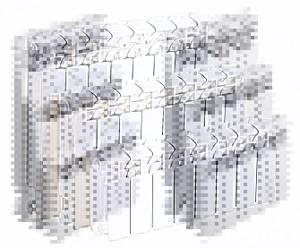
Various sizes of bimetal radiators In simple models, the steel core is present only in the vertical channels. These are so-called semi- or pseudo-bimetallic radiators; although their characteristics are superior to their aluminum counterparts, their degree of housing protection and strength are still insufficient;- More expensive radiators are a solid steel frame, which is filled with aluminum under pressure. This is a real bimetal, and it is these batteries that are recommended to be installed in city apartments.
Design features and types of bimetallic radiators
Each bimetallic heating radiator consists of steel pipes and aluminum panels. Thanks to this, heat is transferred very efficiently without being wasted. Hot water, passing through a core consisting of steel pipes, quickly heats the aluminum shell and, accordingly, the air masses in the room.
The aluminum shaped shell of this core not only looks elegant and stylish, but also helps to better distribute heat. In addition, due to the use of aluminum, the battery is very light (especially when compared with heavy cast iron counterparts). This provides additional comfort during installation. And the intricate design of the case looks great and also significantly increases heat dissipation.

The steel pipes that make up the core are very strong - they can easily withstand pressure from 20 to 40 atmospheres, and hot water temperatures - 110 and even 130 degrees Celsius.
Specific limit values for operating pressure and temperature can be found by looking at the device passport. After all, it depends on the model, and on who made this model.
Today in the store you can buy bimetallic batteries of two types:
1. Radiators that are one hundred percent bimetallic. This means that they have a steel core of tubing surrounded by an aluminum shell. They are characterized by increased strength, leakage is excluded. Such batteries are produced by Italian companies:
- Global Style;
- Royal Thermo BiLiner.
They are also made by Russian manufacturers - for example, the company Santekhprom BM.
2. Semi-bimetallic - radiators that are only half bimetallic. Only the pipes reinforcing the vertical channels are made of steel. In this case, aluminum partially comes into contact with water. These half-bimetallic radiators dissipate heat 10 percent better than the previous type. And they cost 20 percent less.
They are released:
- Russian manufacturer Rifar,
- Chinese – Gordi,
- Italian – Sira.
Experts have not yet come to a consensus, arguing which of the two types of radiators is better for centralized heating and which for individual heating. Thus, the technical characteristics of a bimetallic radiator allow it not to be afraid of “chemistry” in city water. But at increased water pressure, aluminum behaves better. The experts agreed on one thing: if you have old heating pipes in your house (they are more than 40 years old), then it is better to use bimetallic batteries.
Sectional or solid?
The bulk of such radiators are made up of a certain number of sections. That is, first each of the sections is made completely, and then they are connected with nipples. This is done in the factory, the total number of sections is even.
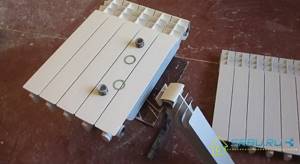
If necessary, a specialist is quite capable of removing an extra section or adding a missing one.
However, in addition to sectional ones, there are also solid bimetal batteries on sale. The core of steel pipes is made immediately of the required size. It is then “wrapped” in a shaped aluminum shell. Such a battery will not burst even if the pressure reaches one hundred atmospheres.
Compliance with State Standards
For all heating systems and their elements there is a single register of State Standards, which they must comply with. Everything is taken into account:
- Quality and safety of production.
- Compliance with temperature conditions and pressure in pipes.
- What should be indicated in the data sheet of the finished product.
- Standards according to technical characteristics and permissible deviations from the norm.
If you want to buy bimetallic radiators, GOST will tell you what parameters they should have, and they must correspond to the indicators in the documentation for each product. If they do not match, it is better not to purchase such products.
Bimetallic radiators do not yet have analogues in quality and reliability among similar products. They can be installed in systems with the most unstable pressure and low-quality coolant. As for semi-bimetallic models, their cost is 20% lower than that of their full-fledged “brothers,” but they can only be installed in autonomous heating systems. The most expensive options for these devices are a combination of copper collectors with an aluminum body, but their heat transfer level is much higher.
When choosing a bimetallic radiator, you should carefully read not only its technical data sheet, but also the reputation of the manufacturer, and remember that these products cannot be cheap. This will prevent you from buying a fake.
Low radiators
This is another design option for creating bimetallic heating devices. Where standard samples do not fit in height, you can use similar products of a smaller height. Here, the interaxial sections of bimetallic batteries are minimized and amount to 200 mm. Moreover, their characteristics do not differ from standard samples. They are also reliable, durable, able to withstand high levels of pressure, and have the same degree of heat transfer. This is because the design of bimetallic batteries remains unchanged despite their small size.
Some manufacturers are lying. They say that the cost of their product is lower because the product is smaller. In fact, what size the radiator is does not matter. They have a different construction: the absence of a horizontal heat exchanger, the vertical core is made of steel. A fake can be identified by the technical passport, which states not the usual pressure of 20-40 atm, but 12-15 atm, which is completely unusual for these devices.
It is not recommended to purchase a similar model for an apartment with central heating. In an autonomous heating scheme they will come into place.

